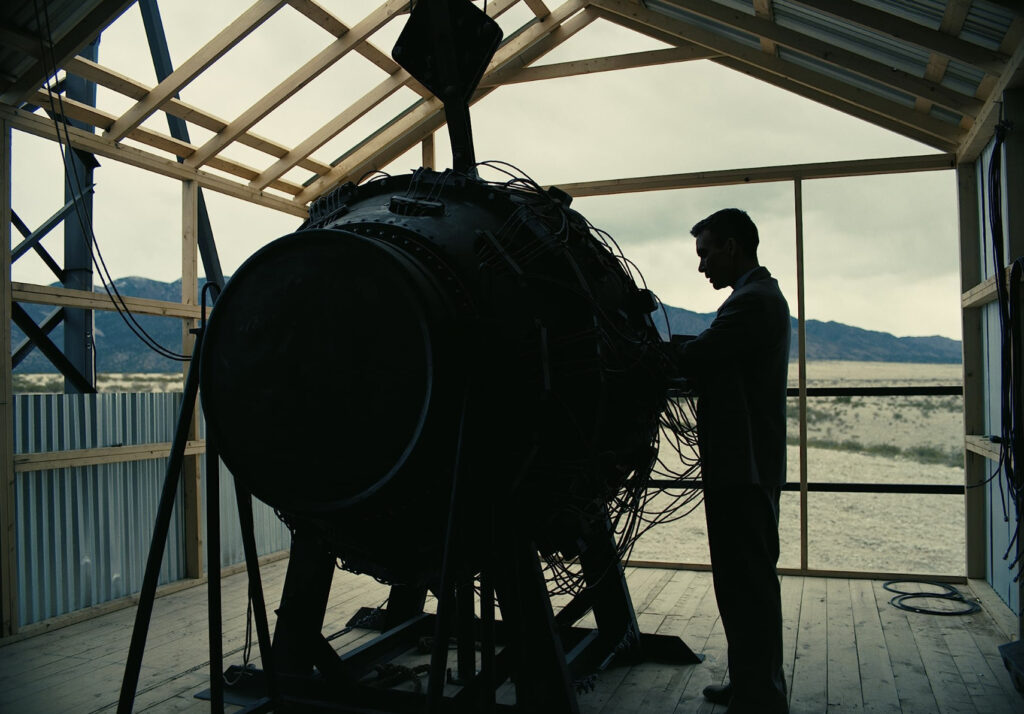It’s Oppenheimer and It’s Ken: “Barbenheimer” as a Study in Masculinity
The following contains major spoilers for Barbie and Oppenheimer.

July 21st, 2023 will likely be remembered as a day that shook the film industry to its core. What initially felt like a showdown between two of the year’s most anticipated films releasing on the same day, quickly morphed into an altogether different phenomenon. Excited moviegoers began using the term “Barbenheimer” when referencing plans for a double feature of Barbie and Oppenheimer, indulging in the best of what cinema has to offer. Heavily coded along gender lines, the two films feel diametrically opposed; a historical epic and a feminist fantasy. One follows an iconic bombshell and the other, the father of the atomic bomb. However, upon closer inspection, these stories have more in common than meets the naked eye. Both center inventions born out of the boomer generation that would irrevocably change the course of history. In addition to their singular titles, both films also feature intense explorations of masculinity. When paired as a double feature, “Barbenheimer” becomes a study in the destructive power of patriarchy and dangerous men who believe it’s their destiny to dominate the world.
Greta Gerwig’s Barbie is an imaginative film that brings the titular Mattel doll to life. Stereotypical Barbie (Margot Robbie) and her diverse group of friends live in a feminist utopia where women have total power and every night is Girl’s Night. The Kens exist on the fringes of this pink paradise and have relevance only when the Barbies give them attention. Set in both the Real World and Barbie Land, Barbie must find the troubled girl who’s been playing with her to heal the rift between dimensions, fix her mysteriously flat feet, and avoid getting cellulite. Desperate for Barbie’s love, Ken (Ryan Gosling) tags along and discovers that the Real World is ruled by men. A single day in Century City, L.A. provides the validation he’s spent ages trying to earn, now freely given to him simply because happens to be male. Ken takes this knowledge of patriarchy (and horses) back to Barbie Land and remakes it in his own image. He shares these new tactics of domination with the other Kens and transforms the Barbies into trad-wife airheads who forget their own ambitions and base their lives around seeking male approval.
Oppenheimer follows the world-renowned physicist J. Robert Oppenheimer (Cillian Murphy) who spearheaded creation of the atomic bomb. Christopher Nolan’s sprawling film chronicles his years building the famed Los Alamos Laboratory and directing the landmark 1945 test detonation at the Trinity Site in New Mexico. This nuclear explosion is the centerpiece of the film and features a stunned Oppenheimer’s famous quote from the Bhagavad Gita, “Now I am become Death, the destroyer of worlds.” The film’s final act concerns the fallout. Once created, the bomb quickly becomes a military tool slipping out of its creator’s grasps. After the catastrophic bombings of Hiroshima and Nagasaki, Oppenheimer begins to advocate for a world-wide peace agreement to prevent a never-ending arms race.

Of the two films, Barbie has the more overt critique of masculinity. With no power in Barbie Land, Ken spends his days languishing in his job as “Beach” and wracks his brain for ways to spend more time by his girlfriend’s side. While it’s extremely satisfying to see a man subject to the same objectification and dismissal women have been navigating for centuries, Gerwig explicitly shows the dark side of this conditional validation. After spending the day in the Real World, Ken revels in the unearned status and automatic power heaped upon him simply because he is a man. He begins to parody masculinity, demanding jobs and demeaning women, drunk with the power his gender provides. He also develops an obsession with horses, calling them extenders of masculinity and tells the other Kens about a world designed to cater to their whims and desires.
Having introduced male domination to Barbie Land, Ken divides the doll community. The Barbies fight back with a tried and true strategy: they distract the Kens by feeding their fragile egos while mounting an insurrection behind the scenes. Once order has been restored, Ken becomes distraught at the thought of going back to his aimless existence. His song, “I’m Just Ken” describes the pain of living as an accessory to someone else’s life. However, in a stunning confession, he admits that unquestioned power does not make him happy either. Without the external validation provided by either Barbie or his performance of masculinity, he has no idea who he is. By asserting that the only path to male happiness is an idealized relationship and the appearance of strength, the patriarchy has harmed him as well.
It’s important to note that none of Ken’s dissatisfaction is Barbie’s fault. She hasn’t denied him anything. She just doesn’t love him. She doesn’t want him to spend the night or move into her dream house and she should not be obligated to share her life with him. Like men in the Real World, Barbie has been allowed to fully explore her own desires without needing a partner by her side. Created to be little more than her companion, Ken believes it’s Barbie’s attention that gives him worth and every second they spend apart feels like a failure. It’s a gender-swapped version of the ideology millions of girls have been raised on. Barbie releases him from these limiting beliefs and encourages him to build an authentic identity while rejecting the rigid gender norms preventing him from finding true humanity.

Just twelve years older than Barbie inventor Ruth Handler, the real J. Robert Oppenheimer was born into a world ruled by men. Though women served as little more than caregivers and helpful accessories in the early 20th century, World War II would irrevocably change this essentialist dichotomy. With men serving in the armed forces, millions of women entered the workforce and filled positions traditionally held by men. Using this liberation as a springboard, Handler created Barbie to provide a doll that wouldn’t require little girls to take on the role of mother in their play. Theorizing that women can be anything, Mattel began to offer Barbies styled as doctors, lawyers, astronauts, and even President, inviting little girls to expand their ambitions and visions for the future. Oppenheimer also began his career imagining new possibilities. The film details his early years as a theoretical physicist and professor investigating black holes before the ability to split the atom combined with Hitler’s invasion of Poland sets him on the path towards weaponry. He’s pulled into a highly secretive Manhattan Project and charged with creating an atomic bomb, the ultimate extender of masculinity.
While Nolan’s film revolves around World War II, we view most of the story from Oppenheimer’s perspective. He receives news of the escalating conflict and scientific developments in war-torn Europe, but sees little of it for himself. While developing the bomb, several colleagues warn him about pursuing this invention including a theory that detonation could set fire to the atmosphere making the earth unlivable. Legendary scientists Niels Bohr (Kenneth Branagh) and Albert Einstein (Tom Conti) further suggest that he must highlight the dangers of using scientific discovery for mass destruction. Oppenheimer agrees, but believes a nuclear weapon in the hands of the Nazis to be the greater threat to humanity. Insisting he has no choice, the conflicted physicist engages in an arms race that proves to be the very definition of destructive masculinity: world superpowers fighting to build the biggest and baddest show of force regardless of the cost.
Having birthed the bomb, Oppenheimer discovers that he’s lit a spark he can’t control. His life’s work now becomes a tool used by others for death and destruction and he watches as others take his research to the next level … and the next. Oppenheimer advocates for dismantling the Los Alamos Lab and dedicates his life to using this weapon of mass destruction as a tool of peace, but finds that the genie cannot be put back into the bottle. Though the bombings of Hiroshima and Nagasaki do indeed end World War II, they begin a decades long arms race with the Soviet Union leading to nuclear proliferation. His concerns about the potential for world-wide destruction fall on deaf ears and he’s dismissed as a crybaby by politicians and generals. Nolan posits that Oppenheimer spends the remainder of his life haunted by the millions of people killed with his cataclysmic invention.
Thoughts of death unite Barbie and Oppenheimer as both protagonists discover the value of humanity when faced with its destruction. Inching towards Existential Thoughts of Death Barbie, an understanding of the Real World causes Barbie to break free of the stereotypical perfection that defines her and to seek beauty in the flaws and complexities of life. As Oppenheimer reacts to news of his invention used against the civilians of Japan, he begins to see the burned and bombed bodies of his friends and loved ones. Finally realizing the full weight of what he has created, he begins to separate the human toll from the thrill of victory and emerges from the escalating cycle of masculinity threatening to destroy the world.

Though usually dismissed as frivolous, clothing also becomes an important link between the two films. Barbie has long been defined by her wardrobe; a vast array of outfits indicating the personality and activity of a particular doll. While Gerwig’s wardrobe is more colorful, Nolan also uses clothing as a signifier. Men in his film wear either military uniforms or some combination of suit, tie, and vest, dividing male characters into two categories. Those in uniforms become an extension of military might while those in suits become representatives of scientific and political power. In the early stages of the Manhattan Project, a friend dissuades Oppenheimer from wearing a uniform and urges him to dress as himself, but gender norms of the time period offer extremely limited options. Other than his signature hat and piercing blue eyes, the powerful physicist is virtually indistinguishable from any other man in the film.
Ken goes through many costume changes throughout his story, each more hilarious and endearing than the last. Finally casting off his fur coat and fanny pack, he settles on a comfortable shirt emblazoned with the words “I am Kenough.” Though wrapped in a joke, this statement implies that the troubled doll has discovered he is more than the uniform of masculinity assigned to him by others. He is more than his relationship to a woman and more than the amount of power he can display. By following an individual path, he’s decided to choose the terms of his own masculinity and found the freedom to be himself.
Barbie ends with the Kens dividing into rival armies and fighting for control of their pink world, a hilarious parody of Oppenheimer’s mission. While the physicist’s intentions are noble, the battle of male destruction his bomb ignites is an escalating one-upmanship in which opposing sides try to dominate as much of the world as possible. The Kens ultimately find peace by giving up their quest to control Barbie Land. They share their unique hopes and dreams along with their fears of inadequacy and embrace each other as equals. Oppenheimer ends with its title character’s realization that he may have started a chain reaction that will eventually destroy the world. While it remains to be seen if this prediction will ultimately come to pass, Barbie offers an uplifting path forward. Combating the plague of toxic masculinity doesn’t just require freeing women from the trappings of patriarchal oppression but in convincing men that they have the ability to transcend limited gender norms as well.
Jenn Adams is a writer, podcaster, and film critic from Nashville, TN. Find her social media nonsense @jennferatu.